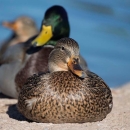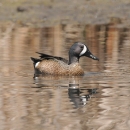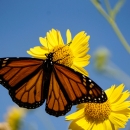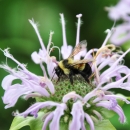Seasons of Wildlife
Spring migration is a great time of year to see all kinds of migratory bird species returning to the area to breed as well as species that are just passing through.
Summer in the tallgrass prairie is always a treat. Wildflowers and grasses are blooming and going to seed. Summer is a great time for frolicking in the flowers.
Fall is a great time to see game animals and take advantage of hunting opportunities.
During the winter, you can see muskrat huts out on the frozen wetlands. If you look closely you may even see wild mink prints in the snow going from muskrat hut to hut as they hunt.
Featured Species
Mallard
Waterfowl production areas are grasslands and prairie wetlands purchased and managed for breeding waterfowl and hunting. The most common duck species found on Litchfield Wetland Management District is the mallard. Mallards are readily visible on district wetlands during spring (March-May) and fall (July-November) migration periods. They use the shallow wetlands to form pair bonds and become more secretive as the hen initiates nesting and incubates her clutch of eggs (April-July). The drake usually abandons shortly after the hen has laid the last egg of the clutch. Broods of ducklings begin to appear on district wetlands around mid-May.
Blue-winged Teal
The blue-winged teal is another abundant nesting duck found on Litchfield Wetland Management District. This small duck is named for its pale blue and white patch on the upper wing that is visible during flight. They are most abundant on district wetlands during spring (March-May) and fall (August-September) migration periods. The blue-winged teal is considered a “dabbling” duck as pairs and small groups up-end (rear in the air) while feeding to reach submerged vegetation instead of diving for their food. They are long distance migrants as some head all the way to South America for the winter.
Grasshopper Sparrow
The U.S. Fish and Wildlife Service is entrusted with conserving and protecting migratory birds. One particular group of birds in special need of conservation is members of the grassland bird community. These are species such as western meadowlark, marbled godwit, sedge wren, grasshopper sparrow and northern harrier rely on grassland habitats to nest and raise their young. In the past 25 years, grassland bird populations have declined in North America more than any other group of birds. In Minnesota, the grasshopper sparrow has suffered a 95% population decline from 1997 - 2011. This is partly due to on-going loss of grasslands. Grassland bird species are present on district lands from March - November.
Tallgrass Prairie
A priority resource of Litchfield Wetland Management District is tallgrass prairie habitat. As the name implies, prairie habitat is dominated by native grasses. These grasses, often three to six feet tall, originally covered large portions of midwestern North America. More than 99% of Minnesota’s original tallgrass prairie has been destroyed! Prairie grasslands are considered one for the most endangered ecosystems in North America. The most dominant species that define the sea of tall grass include big bluestem, Indian and switch grass. In addition to grasses, prairies are alive with wildflowers or forbs (herbaceous plants other than grasses or sedges). The colorful native wildflowers include the purple hues of such species as purple coneflower and blazing star, to the yellow and orange tones of goldenrod, puccoon and butterfly milkweed. The flowers provide a food source in the form of nectar for a plethora of insects, while their stalks, stems and leaves support overwintering and larval forms of butterflies and moths.
Prairie Wetlands
Another priority habitat of the district is prairie pothole wetlands. Roughly half of all Minnesota’s original wetlands have been lost to drainage or filling. More than 90% of Minnesota's prairie pothole wetlands have been destroyed! These wetlands, consisting of marshes, wet meadows and fens, were originally scoured out by glaciers that moved through the region over 10,000 years ago. The district is on the southeastern edge of the prairie pothole region, which is often called the “Everglades of the Prairie” due to the dense, shallow wetlands that once dotted the landscape. This region produces the majority of North America’s ducks leading to the region being dubbed as America’s “duck factory”. The prairie potholes account for just 10 percent of North America’s waterfowl breeding habitat, but the region produces nearly half the continent’s ducks. Chances are the migratory bird you see near your home depends on the Prairie Pothole Region for some aspect of its life cycle.















